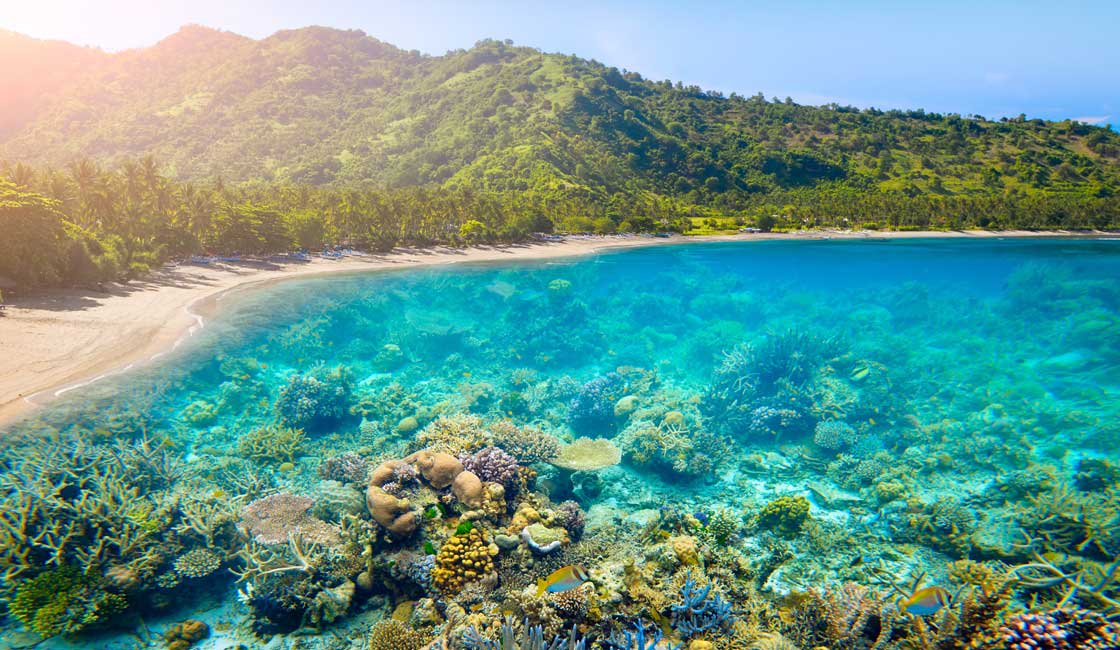
With 17,508 islands, 50,000 miles of coastline, 98,000 square nautical miles of territorial sea, 20,000 square kilometers of coral reefs and some 600 species of coral, 30,000 square kilometers of mangroves forest, six out of seven of the world’s species of marine turtles, and more than 3,000 species of fish—including the largest fish in the world, the whale shark—Indonesia is the epicenter of biodiversity and one of the best places to visit for the ultimate scuba experience.
Due to its vast area, the Indonesian archipelago is truly a liveaboard destination, and offers some of the best liveaboard diving in the world. But it is this immense size—as well as its monsoon season and multitude of micro-climates and changing sea conditions—that makes the question of when to and where to dive a little tricker than in other countries renowned for scuba diving.
There are liveaboards operating in various parts of the country throughout the year, but in general, Indonesia’s diving season is from November to May for diving Raja Ampat, and May to October for diving Komodo. However, most regions of Indonesia can be dived year-round and there are now more liveaboards in Indonesia than in most other scuba diving destinations. Read on to learn more about when and where to dive in Indonesia.
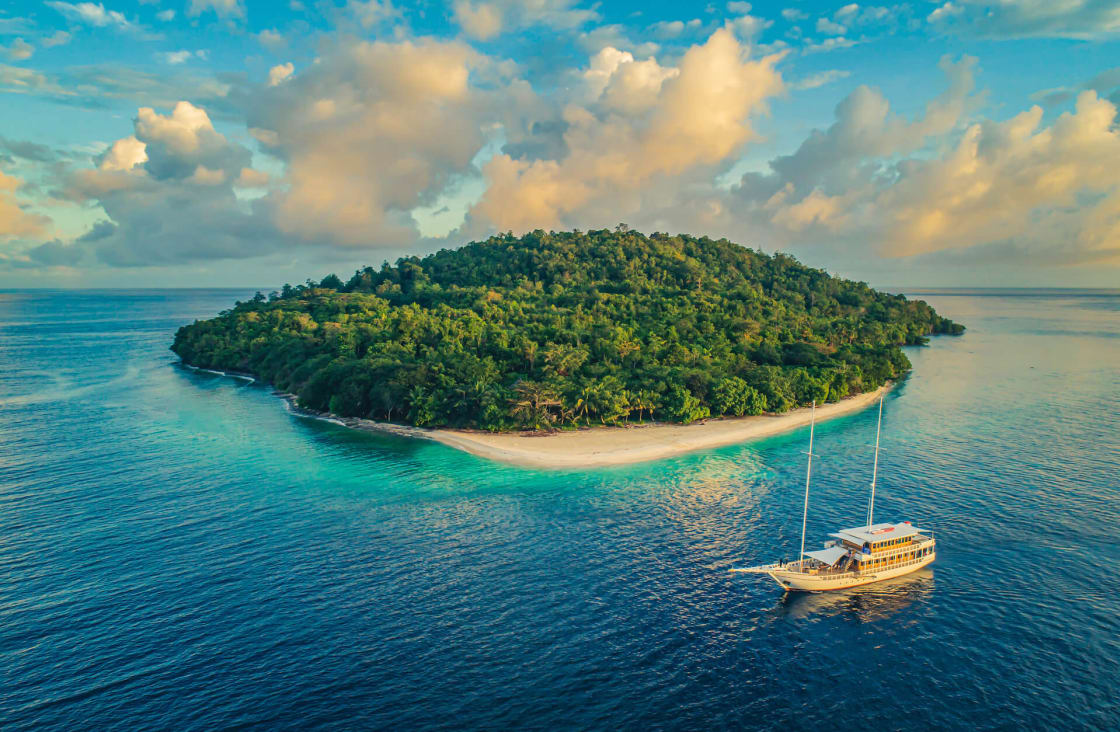
The Fenides liveaboard is just one of many luxurious liveaboards navigating the incredible Indonesian archipelago.
International flights to Bali depart regularly from around the world, often with a transfer in a nearby Southeast Asian city such as Bangkok, Kuala Lumpur or Singapore. If you’re in Southeast Asia already, direct flights are available. Standard itineraries for liveaboards departing Bali are usually Komodo-bound, and there are daily flights from Bali to Labuan Bajo in Flores, which is the start and finish point for many Komodo itineraries. Extended itineraries will venture farther east from Komodo to Flores and Alor for top-class diving without the crowds.
Sorong, in West Papua, is the departure point for liveaboards travelling to Raja Ampat and Ambon in the Banda Sea. From Sorong, dive sites in Raja Ampat and nearby are easily accessible. Domestic flights to Sorong depart from the following airports: Jakarta, Manado, Makassar, and Ambon. Standard liveaboard itineraries departing Sorong will concentrate on the Raja Ampat area, including Cenderawasih Bay for whale sharks.
To reach Sulawesi, you will need to fly to Makassar, and from there for Wakatobi, you need to take another flight to Matahora Airport in Wangi-Wangi island or to Tomia island. Flores and Alor liveaboard cruises use the port of Maumere on Flores. You can fly to Maumere directly from Surabaya, Bali and Kupang. Liveaboard voyages to the Forgotten Islands will normally depart from Timor or Flores. The nearest airport, Maumere, is on Flores and can be reached via Bali or Jakarta.
Let’s now take a deeper dive into Indonesia’s top diving destinations to find out why each should be considered for your liveaboard cruise, including some mentions of the most unmissable dive sites to be found in each.

Komodo isn’t just home to dragons … majestic manta rays also grace its waters, especially at the famous “Manta Alley” cleaning station.
Covering around 900 square miles of sea and land, Komodo National Park is renowned for strong currents, bringing in colder, nutrient rich waters that in turn support one of the world’s most biologically diverse marine environments with over 1000 species of fish. From pristine corals, mantas, sharks, turtles, dolphins, and giant pelagics to tiny pygmy seahorses, nudibranchs, shrimps and frog fishes, Komodo is one of the most accessible and best places to scuba dive in Indonesia with sites varying from gentle slopes to walls, channels, flat bottoms, pinnacles, overhangs and caves covered by hundreds of different species of hard and soft corals.
Dive the famous Manta Alley where you can spot up to a dozen oceanic manta rays swirling through a feeding station, or dive the Shotgun, which is a swift drift that will send you on a ride to remember. Komodo has year-round diving but April to November offers the very best conditions, with August in particular being the best month for Mola Mola. Outside of this time, plankton blooms may reduce visibility a little bit, but this increases the chances of manta ray encounters which are most frequent between December and February.

Raja Ampat and West Papua’s waters are world-renowned for their bewildering biodiversity, including whale sharks.
The Raja Ampat archipelago straddles the equator off the extreme north-western tip of the Papua province of Indonesia. Comprising 610 – 1,500 islands, depending on the accepted distinction between an island and a rocky outcrop, the region is one of the most noteworthy ecological niches on the planet, offering many of the best dive sites in Indonesia. Marine biologists have established that the region is home to 75 percent of the known coral species on the planet, and many of the fish, corals and crustaceans that live in these waters are found nowhere else on Earth.
With vast and pristine coral reefs that are fed by the largest movement of water in the world, you’ll have more than a few chances to spot everything from tiny macro critters such as pygmy seahorses, nudibranchs and ghost pipefish, cuttlefish and crustaceans to large pelagics, tuna, barracuda, reef sharks, walking sharks, manta rays and turtles. The region is also home to rare endemic species such as the tasseled wobbegong shark. Other highlights include large schools of fish, including Spanish mackerel.
One of the best sites is Lao Lao, where the highlight is the huge school of brightly colored ribbon sweet lips that fight the current in unison at the bottom of the reef. Many consider Raja Ampat’s Cape Kri as the best diving in the world, since it holds a record for the most fish species (374) found in one single dive. There’s also an excellent chance of spotting marine mammals including dolphins, whales and even dugong.
On the north coast of West Papua, Cenderawasih Bay is a hot spot for snorkeling and diving with whale sharks in Indonesia. In Raja Ampat and the West Papua Province some of the liveaboard charter boats operate all year although most restrict their season to October to April when there is less chance of rain and choppy seas. Mantas are more frequently sighted during these months.
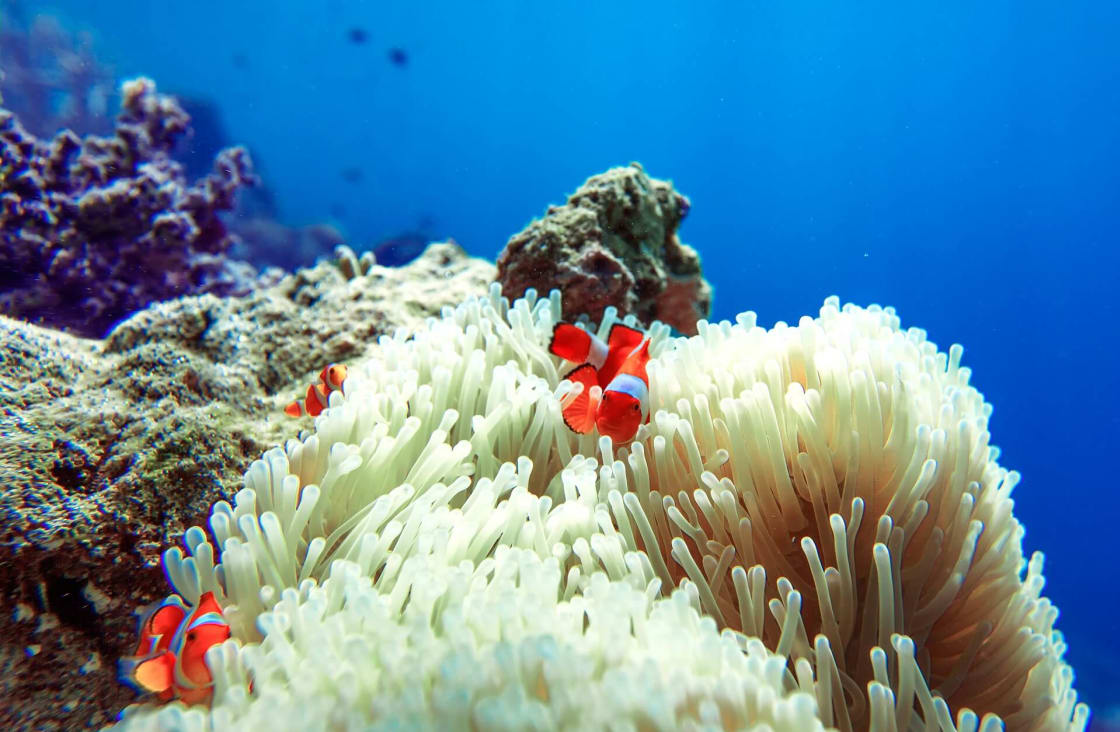
Find Nemo (colorful clownfish) and more in Maluku’s marvelous Banda Islands.
The Banda Islands are a group of eleven small volcanic islands belonging to the Indonesian province of Maluku, located in the Banda Sea, which is home to some of the world’s richest and healthiest reefs, unspoiled corals, steep drop offs, and large pelagic fish. Schools of jacks are a familiar sight, as are big tuna, turtles, napoleon wrasse, groupers, rays, sharks and large lobsters.
The visibility is superb, and there are also some special critter sites. At Karang Hatta, you’ll find huge schools of fusiliers that together create a big cloud of yellow and blue. Moreover, you will find some of the largest sponges you have ever seen. Manuk, also known as Snake Island, is one of the best spots to view sea snakes, while Ambon offers incredible muck diving. The best time of year for diving in the Banda Islands is March and April, and from September to December.
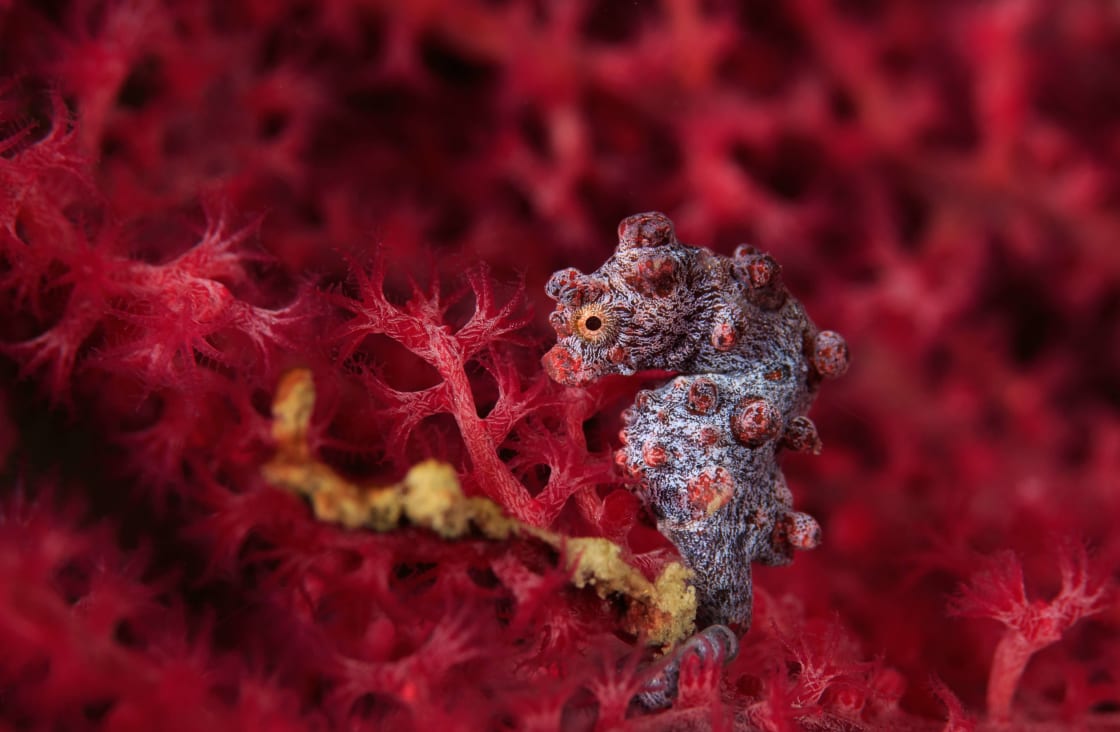
A pygmy seahorse clings to coral in Indonesia’s Forgotten Islands, which are definitely anything but forgettable from a diving perspective.
The Forgotten Islands are, by any reasonable standard, remote, covering a 600-mile-long chain of islands starting at Timor in the southwest, through the Banda Sea and all the way to West Papua in the northeast. These islands represent the final frontier for diving in Indonesia, with multiple sites to choose from and many more yet to be discovered. They are only accessible by Indonesian liveaboard and are therefore rarely visited.
There is a lifetime worth of amazing dives to be enjoyed in these islands, made all the more enjoyable by the amazing visibility and warm waters of around 81-86°F. A special treat is to see the whale sharks who come to feed on the plankton that is pushed from depths by strong currents. Dive sites here are characterized by endless unexplored reefs and spectacular deep walls covered in soft corals, huge barrel sponges and enormous sea fans.
There will be fantastic opportunities for pelagic sightings and schools of larger fish such as barracuda and mackerel, as well as the chance to meet schooling hammerhead sharks, reef sharks, napoleon wrasse, mobula rays, bumphead parrotfish, eagle rays, turtles, thresher sharks, schooling jacks, surgeonfish and fusiliers. You can expect long walls with extremely healthy coral life and immaculate seamounts.
Keep your eyes peeled for pygmy seahorses, nudibranchs, ghost pipefish, octopus, triggerfish, lionfish, moray eels, scorpionfish and dragon shrimps. There are also many attractive rock formations to find, including swim-through windows, pinnacles and overhangs.
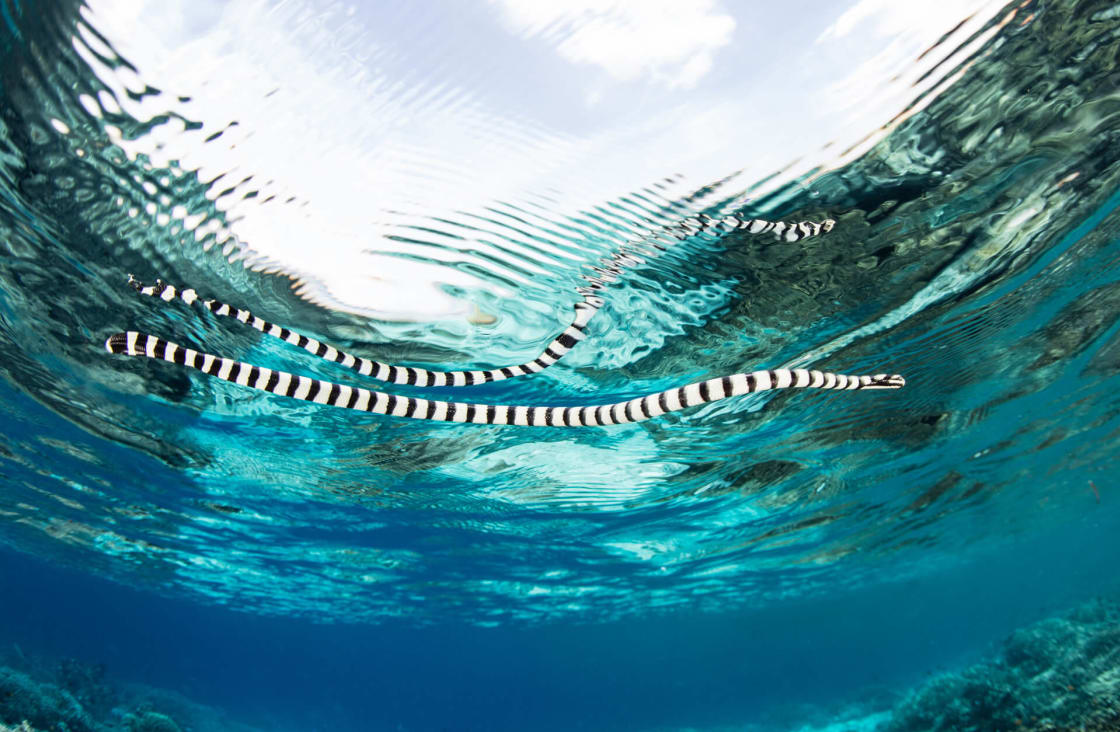
A Banded sea krait swims just under the surface of the water in Sulawesi’s Wakatobi National Park. The snakes occasionally surface to breathe.
Sulawesi presents a diverse and beautiful landscape. Volcanic peaks form the backdrop for forests, jungles, rolling highlands, and over 3,700 miles of dramatic coastline. There are three main dive areas around Sulawesi: Bunaken National Park, Lembeh Strait, and Wakatobi National Park in the southeast. Each of these regions offers divers different features, sightings and experiences including fringing reefs, sheer walls, muck diving, large pelagic species, and rare crustaceans and fish.
The name Wakatobi is an acronym of its four main islands, which are: Wangi-wangi (WA), Kaledupa (KA), Tomia (TO) and Binongko (BI). It’s also a Marine National Park, the second largest coral reef in the world, with more than 750 species of fish, 850 known types of coral, and 50 spectacular dive spots. It is home to some of the most pristine reefs and wall diving in the world, with a wide variety of coral formations, unique underwater topography, and a rich fish and critter life.
Roma is perhaps the best-known dive site at Wakatobi, with a pinnacle that rises from the depths to within seven feet of the surface and is covered in the most astounding assortment of corals. The fringing ring of potato coral around the crest gives the dive site its name, thanks to its resemblance to the Colosseum in Rome.
The Bunaken National Park enjoys the best conditions from March to October with July and August being the busiest months. July and August are also the best months for critter spotting in Lembeh. The best time of year for diving Wakatobi is March to December.
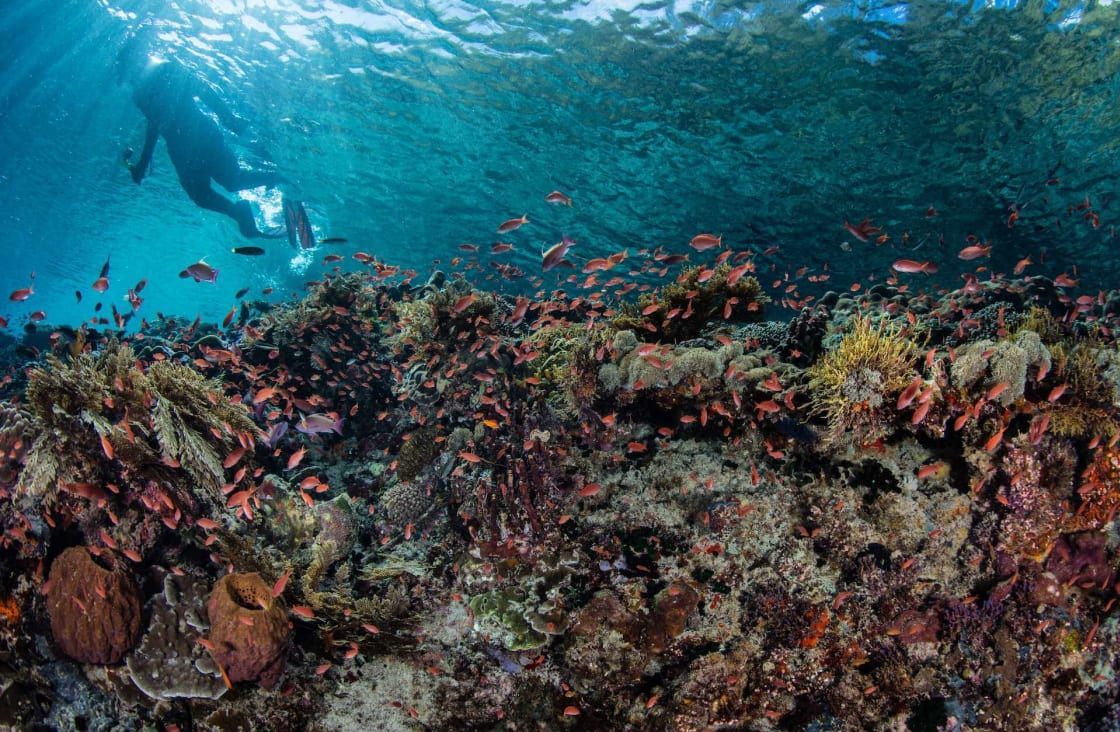
Colorful reefs abound in the astonishing Alor archipelago.
The Alor archipelago is one of Indonesia’s best, yet least-known, dive hotspots. The Pantar Strait Marine Park consists of three volcanic islands boasting super-saturated colors, one of the most well-preserved coral reef systems in Indonesia, and abundant marine life boosted by the strong currents found here. The narrow strait offers a great variety of dive sites with steep drop-offs, pinnacles lined with anemones and nudibranchs, and beautiful, densely covered coral reefs featuring super-saturated colors.
Expect to see rhinopias, pygmy seahorses, manta rays, schooling dolphins, hammerhead sharks, pilot whales and the occasional migrating blue whale. Kalabahi Bay is renowned for its muck diving opportunities on the black sandy volcanic rock slope
So now you know when and where to go diving in Indonesia, I guess the only question left to ask yourself (or our experts) is, which luxurious liveaboard should you take your Indonesia diving cruise on?
While Rainforest Cruises aim to provide accurate and up-to-date information, we make no representations as to the accuracy or completeness of any information herein or found by following any link on this site. Rainforest Cruises cannot and will not accept responsibility for any omissions or inaccuracies, or for any consequences arising therefrom, including any losses, injuries, or damages resulting from the display or use of this information.




